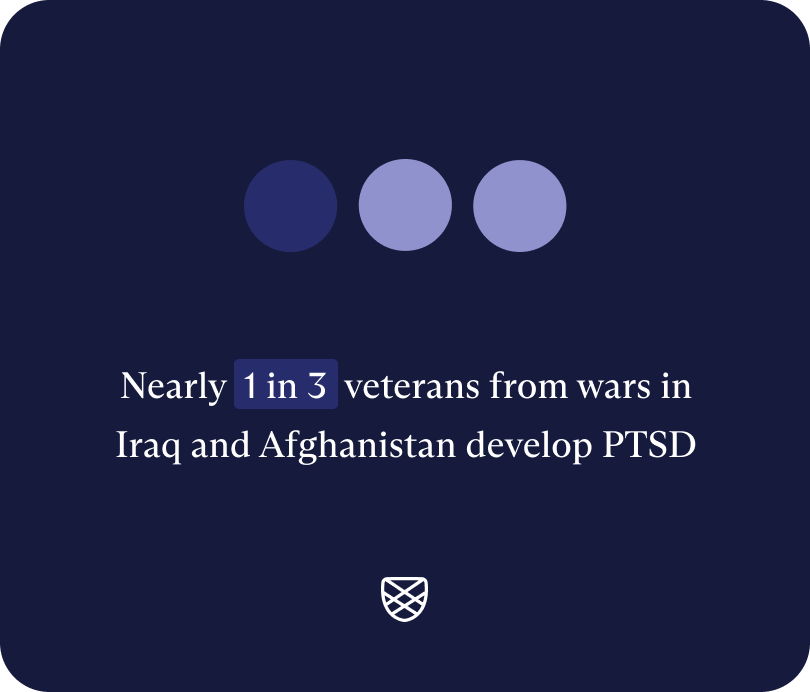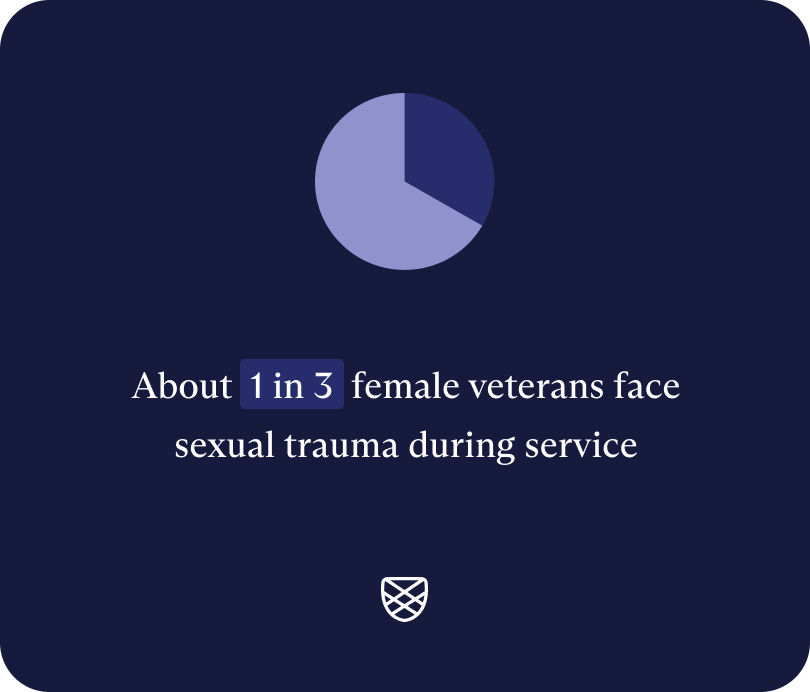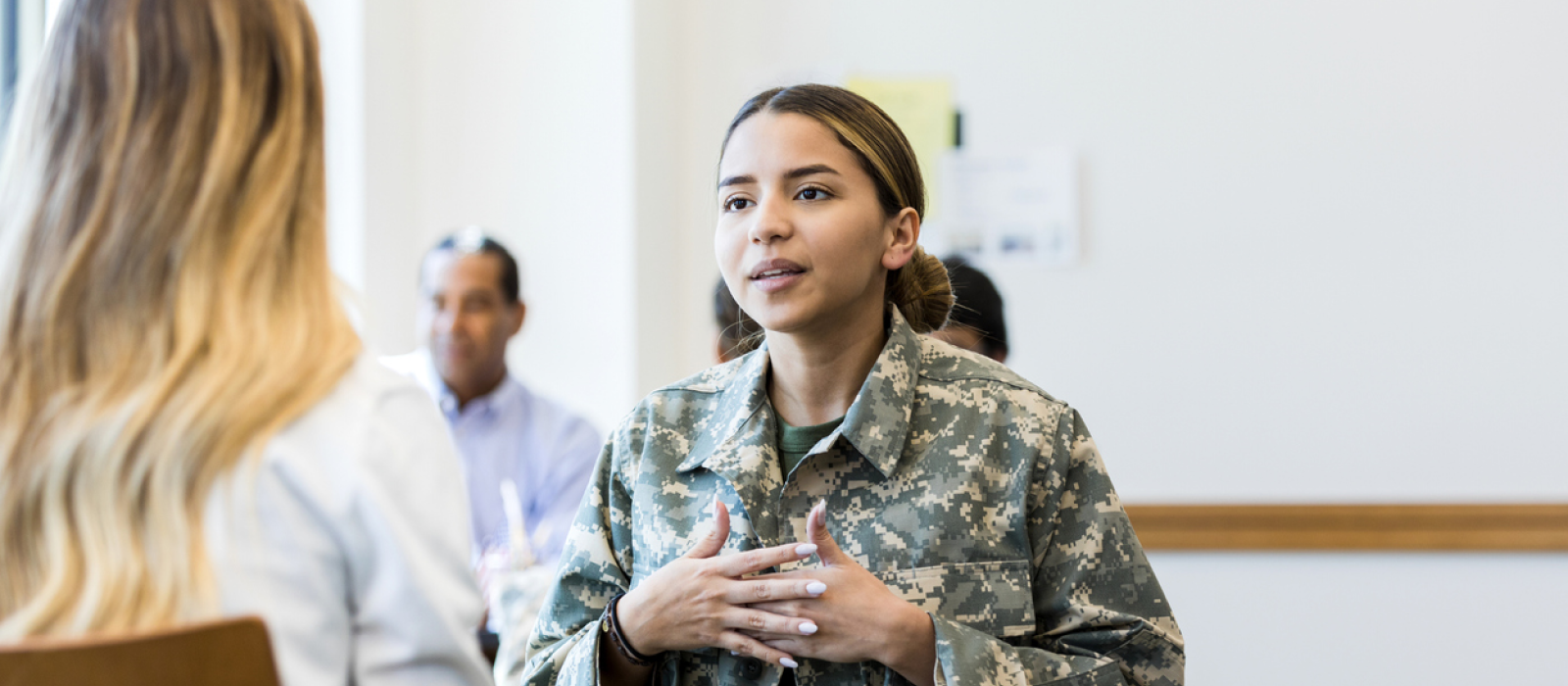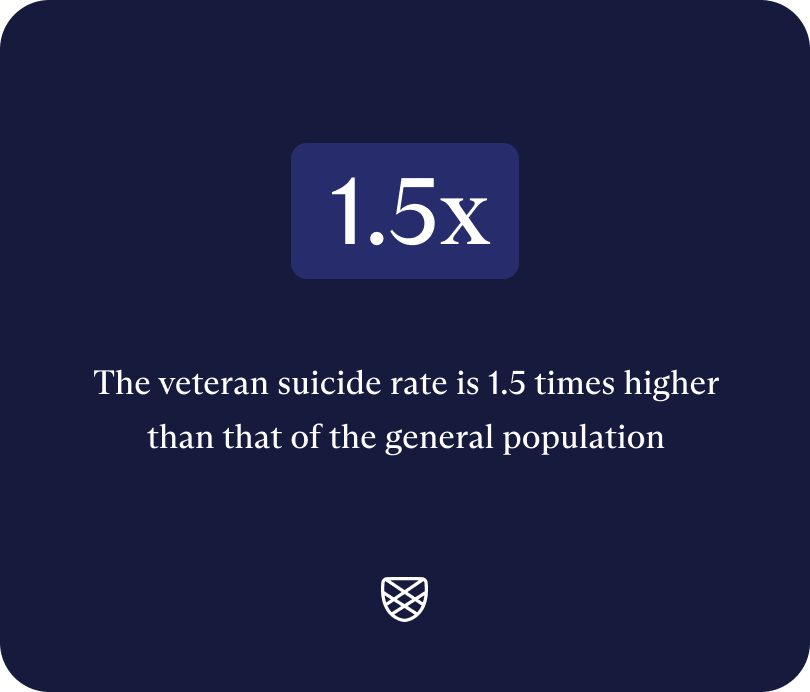
Table of Contents
7 Alarming Veteran Mental Health Statistics (and Tips for Support)
Written By: Charlie Health Editorial Team

Clinically Reviewed By: Dr. Don Gasparini
February 1, 2024
5 min.
Data that highlights the veteran mental health crisis and resources to cope with PTSD and other mental health conditions.
Learn more about our Clinical Review Process
Table of Contents
Active military service lasts for a handful of years on average but can have a lifelong impact on mental health. Military veterans are more likely to deal with mental health conditions and traumatic brain injury than non-veterans, data shows. A 2014 study found that one in four veterans meet the diagnostic criteria for a mental health issue, with one in 10 struggling with multiple conditions.
Among the most commonly diagnosed conditions is post-traumatic stress disorder (PTSD), which originated from research on Vietnam War veterans. According to the U.S. Department of Veteran Affairs (VA), about 7% of veterans will experience PTSD at some point in their life, compared to 6% of civilians. PTSD rates differ by service era, significantly increasing since World War II, and risk factors like deployment, which triples the likelihood of diagnosis.
Another prevalent condition among veterans is substance use disorder (SUD), which commonly co-occurs with PTSD. The VA found that more than one in five veterans with PTSD also have SUD, and about one-third of veterans seeking treatment for SUD also have PTSD.
Although these conditions are treatable, factors like stigma, financial barriers, and VA healthcare system issues stop some veterans from accessing needed mental healthcare, data shows. The outcome can be dire: roughly 17 veterans die by suicide each day, according to a 2022 report. If you’re having thoughts of harming yourself or someone else, this is a mental health emergency, and you should contact the 24/7 Suicide & Crisis Lifeline by calling or texting 988.
Below, Charlie Health outlined some of the most alarming veteran mental health statistics, which shed light on the veteran mental health crisis. We also offered some evidence-based tips for coping with conditions commonly seen in military personnel. Whether you or a loved one have served in the military, it’s important to stay informed about veteran mental health and know how and when to get needed mental healthcare.
Join the Charlie Health Library
Get mental health updates, research, insights, and resources directly to your inbox.
You can unsubscribe anytime.
7 alarming statistics about veteran mental health
1) Nearly 1 in 3 veterans from wars in Iraq and Afghanistan develop PTSD

A large study of veterans found that nearly one-third (29%) of those who served during Operation Enduring Freedom and Operation Iraqi Freedom will develop PTSD at some point in their lives. As mentioned, veteran PTSD rates vary based on many factors, including service era. According to the VA, lifetime veteran PTSD rates have increased more than eightfold since World War II, though the department notes that study methods may impact this data.
2) PTSD rates among female veterans are more than double those of male veterans
Gender is another factor that affects PTSD rates among veterans. Female veterans are more than twice as likely to experience PTSD (13%) as compared to male veterans (6%), according to the VA. The VA is still in the process of learning more about PTSD rates among transgender and non-binary veterans.
2) About 1 in 3 female veterans face sexual trauma during service

Military sexual trauma, the term used by the VA, accounts for all sexual assault and sexual harassment that happens during military service. Among female veterans seen by VA providers, rates of military sexual trauma are about one in three—considered a possible driver of high female veteran PTSD rates. About one in 50 male veterans report military sexual trauma, too. However, the department notes that this data doesn’t account for veterans seeking non-VA healthcare.
4) About 1 in 10 veterans returning from war in Iraq and Afghanistan struggle with alcohol or drug use
PTSD is not the only mental health condition affecting military service members. Substance use disorder (SUD) is also common, affecting about one in 10 veterans returning from war in Iraq and Afghanistan, according to VA data. As mentioned, SUD also often co-occurs with PTSD among veterans (and non-veterans).
5) About 1 in 10 outpatient military clinic appointments is for depression
Research shows that 9% of all appointments at outpatient military clinics are for depression. The military setting can trigger and worsen depression, with factors like separation from loved ones, combat stress, and exposure to danger increasing the risk for both active-duty personnel and veterans.

6) Since 9/11, military suicide rates are four times higher than deaths in war operations
Death by suicide has long been a driver of veteran mortality, accounting for four times as many deaths as those in war operations since 9/11, according to a recent paper. The paper also concluded that this finding means the veteran suicide rate is outpacing the suicide rate among non-veterans for the first time since the Vietnam War.
7) The veteran suicide rate is 1.5 times higher than that of the general population

Specifically, the veteran suicide rate is 1.5 times higher than that of the general population, according to the 2023 National Veteran Suicide Prevention Annual Report. In fact, suicide is the second-leading cause of death among veterans under 45 years old, the report concluded.
3 tips for supporting veteran mental health
The conditions most commonly seen among veterans are treatable, and many veteran deaths by suicide are preventable. On a macro level, and above all, healthcare providers need to know the warning signs of mental health crises and increase military cultural competence. If you’re a veteran or have a military family member, though, there are still things you can do to promote veteran well-being. Here are three tips for supporting veteran mental health:
1) Try meditation or yoga
Both mindfulness exercises have been shown to improve PTSD symptoms when used in conjunction with other mental health support, like therapy and medication.
2) Know the signs of a mental health crisis
Research shows that identifying and talking about suicidality can reduce the risk of suicide, which is why it’s important to know the warning signs of a mental health crisis. Some common signs of a mental health crisis include:
- Expressing feelings of hopelessness or having no reason to live
- Withdrawal from friends, family, and activities
- Giving away possessions or making final arrangements
- Increased use of alcohol or drugs
- Overwhelming sadness or emotional numbness
Consider using online resources like those from the American Foundation for Suicide Prevention or talking to a mental health professional for more information.
3) Reach out for help
Stigma and lack of access keep many veterans from accessing the mental healthcare they need, but remember, asking for help is a sign of bravery. Most VA clinics have resources and mental healthcare referrals, and there are many options online. If you’re looking for more than once-weekly mental health support from clinicians with military cultural competency and others who get it, consider Charlie Heath.
References
https://www.ncbi.nlm.nih.gov/pmc/articles/PMC6069794/
https://www.ptsd.va.gov/understand/related/substance_abuse_vet.asp
https://www.ptsd.va.gov/understand/common/common_veterans.asp
https://pubmed.ncbi.nlm.nih.gov/24590120/
https://www.ncbi.nlm.nih.gov/pmc/articles/PMC4671760/
https://www.goarmy.com/explore-the-army/army-structure/active-duty.html
https://www.ptsd.va.gov/understand/common/common_veterans.asp
https://www.ncbi.nlm.nih.gov/books/NBK572092/





